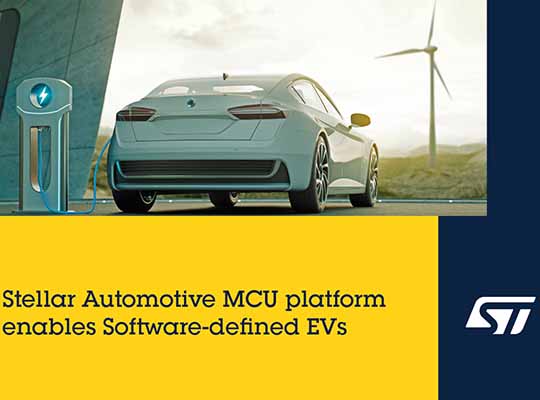STMicroelectronics has unveiled new automotive microcontrollers (MCUs) optimized for electric vehicles and centralized (domain and zonal) electronic architectures. They enable EVs to become more affordable, drive further, and charge faster.
In current EVs, high-efficiency SiC-based (silicon carbide) power modules enable the greatest driving range and faster charging. Until now, they have required dedicated high-speed signal processors to control the advanced SiC power semiconductors. ST’s Stellar E MCUs, designed for the next generation of software-defined EVs, integrate high-speed control-loop processing on-chip. Now one MCU can control the entire module. This simplifies the module design, saves costs, and eases compliance with automotive safety and security standards.
The new MCUs extend ST’s Arm®-based Stellar family and are designed from the ground up with the car as a platform in mind. As a powerful, centralized domain and zone controller, the family simplifies automotive electrical architectures for increased power, flexibility, and safety. Currently, the MCUs family includes Stellar P series for integration and vehicle control and the Stellar G series for body applications. The Stellar family architecture integrates multiple Arm Cortex cores that deliver high performance with the opportunity for lock-step redundancy and support real-time hardware virtualization. All Stellar devices are designed for software upgradeability through secure over-the-air (OTA) updates.
“Our Stellar MCUs enable state-of-the-art electrification while ensuring efficient energy management and software-defined flexibility for vehicle lifecycle management,” said Luca Rodeschini, Automotive and Discrete Group Vice President, Strategic Business Development and Automotive Processing and RF General Manager, STMicroelectronics. “With the new Stellar E devices, this platform now enables a new value chain for EVs. Sensing the environment, controlling vehicle dynamics, enhancing power-conversion efficiency, and safely managing high-current power stages, are effectively handled in a single component. The ability to update software securely over the air lets manufacturers refine their control strategies for extra driving range, performance, and power efficiency.”
The first product in the Stellar E series, the Stellar SR5E1 optimized for EV on-board chargers (OBC) and general DC/DC converters, is now sampling to lead customers. Full production will begin in 2023.
Further technical information
High-power applications in electric vehicles, namely the OBC, e-drivetrain, and various DC/DC converters, are achieving tremendous gains in energy efficiency and reliability leveraging silicon-carbide (SiC) power transistors and diodes. These gains are maximized by operating at switching frequencies significantly higher than the frequencies appropriate for ordinary silicon power semiconductors.
Typical automotive MCUs in the market today cannot execute the charging-control algorithms at a rate that can support the higher SiC switching frequencies. Instead, additional DSP chips are needed specifically to handle the control loop. These require separate coding and add to the bill of materials and complexity of the control module implemented with traditional MCUs, increasing the cost, size, and power consumption.
The Stellar E (Stellar Electrification MCUs) series now provides automotive-qualified MCUs that perform the high-speed control-loop processing alongside general control in the same chip. This simplifies design and streamlines the bill of materials, easing the transition to high-efficiency SiC-based power modules that permit extra driving range and faster charging.
These MCUs can control multiple power converters, leveraging features including a high-speed analog-digital converter (ADC), highly accurate pulse-width modulation (PWM) controller, and fast-acting protection circuitry.
Moreover, the Stellar E series supports the leading automotive standards for functional safety (ISO 26262 ASIL-D), security (HSM -), and industry standard SW interoperability (via Autosar 4.3.x), as well as secure OTA update. Designing with the Stellar family delivers further benefits including extensive software-development toolchain, with a common ecosystem for control and actuation.
Further information can be found at www.st.com.













